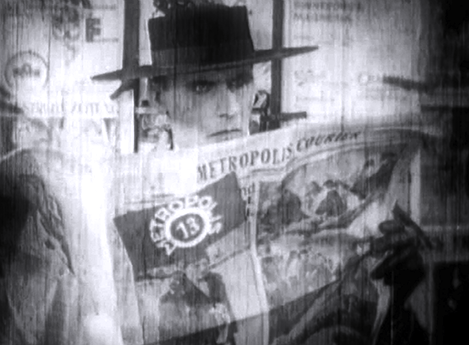Metropolis 27/10 – “We Are Keeping A Close Eye on You!”

This isn't Clark Kent: The re-discovered Thin Man (Fritz Rasp), Joh Fredersen's private eye, observes the patriarch's rebellious son Freder (courtesy Murnau-Stiftung / Museo del Cine)
On February 12, 2010, the Friedrich-Wilhelm-Murnau-Foundation’s almost completely restored original Metropolis 27/10 version celebrated a highly acclaimed premiere performed live in two cities simultaneously: in Frankfurt am Main’s Alte Oper as part of the interdisciplinary project cooperation Phänomen Expressionismus as well as at the Friedrichstadtpalast on the occasion of the 60th Berlin International Film Festival. [1]
The newly adapted music score, which is based on the original 1927 one, has accompanied both screenings. In Berlin, the Rundfunk-Sinfonieorchester Berlin played under the direction of Frank Strobel, and in Frankfurt, the Staatsorchester Braunschweig performed under the direction of Helmut Imig. The Franco-German culture channel arte took the chance to broadcast the event live on TV – and, an intrepid crowd of cinephilic die-hards gathered in the winter’s cold in front of the Brandenburg Gate at Berlin’s Pariser Platz. [2]
From Babylon to Belsen
From a PHUTURAMA perspective there is nothing new in Metropolis 27/10. The lost scenes, fortunately saved by an Argentinian distributor immediately after the controversial Berlin premiere of 1927, were expurgated from Fritz Lang’s original cut at least to save the commercially crucial U. S. exploitation, but it almost completely ruined Metropolis’ narrative structural integrety for decades.
It is now becoming clear that the until then very chlichéd story (“The New Tower of Babel”) is primarily propelled by the fundamental clash of the two big egos of Johann “Joh” Fredersen and the inventor Rotwang who were the founders of the gigantic high-tech city of Metropolis. They split up because of their love for the same women called Hel. She tragically passed away whilst giving birth to the son of the lately victorious Joh Fredersen who had become the undisputed hegemon of the vertically integrated Great Society of Metropolis – a Fordist nightmare of class segregation.
The brilliant, but finally vanquished Rotwang never overcomes his defeat and so he constructs a robotic (wo)man-machine to substitute his late beloved and idolised Hel. But it’s not Hel who is eventually becoming the matrix of the iconic Mensch-Maschine, it’s a young woman named Maria preaching the virtues of love and reconciliation to the impoverished workers in the abandoned Unterstadt catacombs. From the first accidental encounter in the Oberstadt’s elitist Forever Gardens it is this woman who Freder Fredersen – the magnat’s rebellious son and ‘mediating’ heart of the story – has fallen in love with.
After Rotwang disclosures his secret surrogate of Hel to Joh Fredersen, the patriarch himself forces the inventor to alter the robot form to replicate the new girl in town, Maria, who is evidently becoming a menace to the authorities. Fredersen is intending to use Rotwang’s ingenious automaton to regain his influence over the workers and his dissident son. Rotwang assents only perfunctorily to Fredersen’s plot, aiming to execute cold revenge against the rival and to destroy his metropolitan supremacy. The ‘fake’ Maria is attended to spur the underprivileged working class on to ultimately rage against the machine. The ‘machine’ as in Herz-Maschine, epitomising the entire system, not as in Mensch-Maschine. The uprising against the latter ironically comes to pass as a consequence of the first, when both villain’s sinister ambitions happened to fail by epic proportions.
The arch-malefactor Rotwang’s plot doesn’t succeed in the end, thanks to the original, humane and saint-like Maria and her loving redeemed ‘Mediator’ Freder Fredersen. After a joint heroic rescue of the lUnterstadt children abandoned by the catastrophic surge as the insinuated consequence of the unleashed underclass’s rioting, Labour and Capital close a historic compromise in front of the holy church – citing the movie’s initial Sinnspruch: “The Mediator Between the Hand and the Brain Must be the Heart.”
This happy ending is emblematic in the context of the profoundly disturbed Weimarer Republik of the 1920s, when the Nazi regime could eventually achieve a sort of long yearned ‘compromise’ between the hand and the brain by a charismatic leader, advanced political propaganda, and brute as well as total terror – domestically and abroad.
The Anti-Modernist Monument
Metropolis prophetically envisioned the Holocaust avant la lettre in the hallucinatory sequence of the illuminated Freder Fredersen when he is confronted for the first time with the exploited workers’ misery at the central Herz-Maschine which then mutates for him into a giant man-eating Moloch of industrial mass-destruction.
There are lots of fascinating motifs of religious thought and tradition which make Metropolis’ intention look very alt-fränkisch and sceptically anti-modernist in contrast to the prevailing ultra-futuristic commonplaces like man-machine interfaces, video-phones and mile-high towers in the skies. So, beyond its iconic and paradigmatic visual as well as cinematographic qualities, Metropolis 27/10, in its reconstructed narrative, becomes an important historic witness to the unique and fatal Anti-Western mental state of Germany’s pre-Third-Reich society.
[1] The Official Website of the 60th Berlin International Film Festival
[2] metropolis2710 – The Special Website of “The World Premiere of the Restored Version of Metropolis in Frankfurt and Berlin”

Leave a Reply